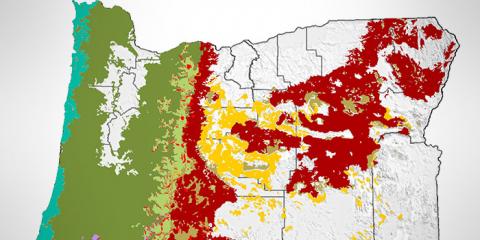Oregon's diverse forests
December 29, 2016
We at OFRI are just putting the finishing touches on the 2017-18 edition of our popular Oregon Forest Facts & Figures publication. As I compiled information about Oregon’s forests to update the Facts & Figures booklet, I was struck by the diversity of the forests in this state.
Variances in climate, average rainfall and wildfire frequency across Oregon affect the types of trees that grow in different parts of the state, as seen on this interactive forest types map. As a result, each forest requires a different sort of management, grows at a different rate and produces different types of timber.
Oregon’s forests also have a range of owners with different management objectives, including providing recreational opportunities, improving wildlife habitat and harvesting timber. To see how forest ownership varies across the state, check out this interactive map.
Here are a few of the many reasons our forests are so diverse:
Diversity of Forest Types
Forests of Oregon can be placed in three general types, based on geography:
Dry forests in central and eastern Oregon commonly have mixtures of ponderosa pine, Douglas-fir, grand fir and western larch trees. Historically, low-intensity wildfires visited these forests every two to 25 years.
Wet forests in northwest Oregon commonly have mixtures of Douglas-fir, western hemlock, western red-cedar and bigleaf maple. These forests historically burned at intervals of 200 years or longer, and the fires were generally very intense, killing most of the trees.
Southwest Oregon forests are a mixture of Douglas-fir, ponderosa pine, incense cedar and a variety of evergreen hardwoods. These forests are intermediate in fire behavior and historically burned with mixed severity every 25 to 100 years.
Diversity of Ownership and Objectives
There are three major types of forest owners in Oregon, each with different management styles:
Federal forests make up about 60 percent of Oregon’s forests. These include our 11 national forests, Bureau of Land Management lands and Crater Lake National Park. Some federal lands are managed under a reserve strategy where timber harvest is either not allowed or allowed only to improve habitat or other non-timber values. Other federal lands are managed on a multiple resource strategy for both timber production and non-timber values. In 2015, Oregon’s federal forests produced about 15 percent of the state’s timber harvest.
State forests comprise only about 4 percent of our forests. These include our six state forests and other scattered parcels. State forests are generally managed for multiple resources with focus on timber harvest, wildlife habitat and recreation. In 2015, Oregon’s state forests produced about 9 percent of all timber harvested here.
Private forests encompass the remaining 36 percent of Oregon’s forestland. Private lands are the most diverse in objectives, including lands owned by large companies, investment groups, families and Native American tribes. Private forests are the most intensively managed forests, and produce over 75 percent of the state’s timber harvest. When harvesting timber, private landowners must follow the Oregon Forest Practices Act. The set of state forest protection laws is aimed to safeguard water, fish and wildlife habitat, soil and air. Additionally, nearly 50 percent of Oregon’s private forests are certified as sustainably managed under either the Sustainable Forestry Initiative, the Forest Stewardship Council or the American Tree Farm System.
Whether we’re talking about forest types or forest ownership groups, there is much diversity among Oregon’s forests. This adds greatly to our bio-diversity, cultural diversity and economic diversity as a state – something else to be proud of about Oregon.
For the forest,
Mike Cloughesy
Director of Forestry
